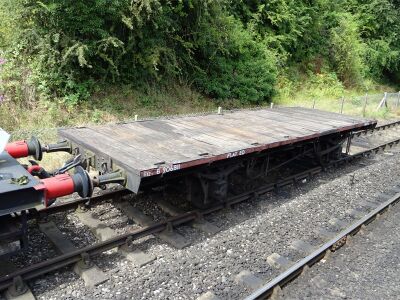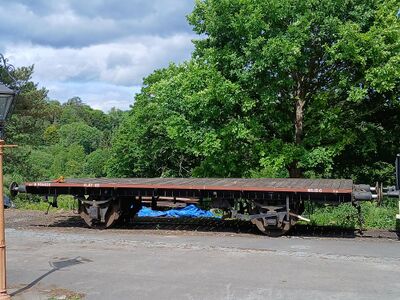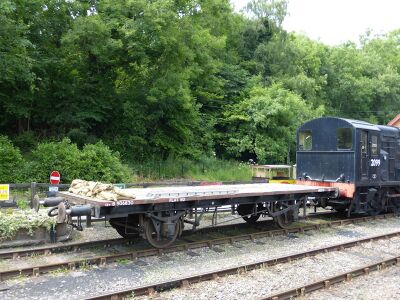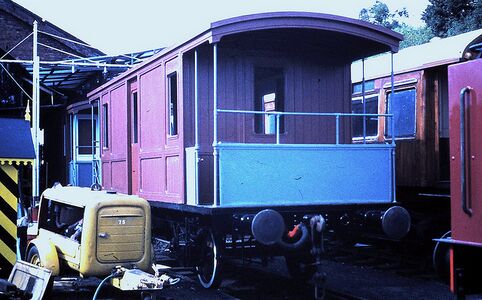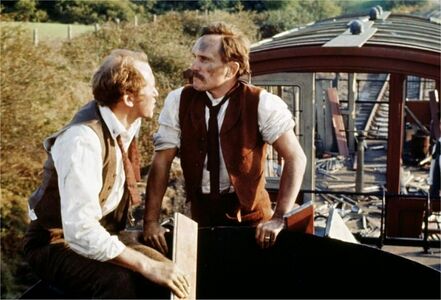BR 'Flat ED' wagons
The SVR is home to three BR Flat ED wagons, thought to be the only surviving examples of the 32 originally built.[1] They arrived in 1975 for use in filming The Seven-Per-Cent Solution, although their actual identities were not confirmed until the 1990s.
Special wagons[edit | edit source]
Under the requirements of early legislation, railway companies were established as 'common carriers' who were required to transport such exceptional traffic as was offered to them. This led to their building and maintaining a stock of sundry sizes and types of specially constructed wagons in anticipation of these demands.[2]
Following nationalisation, BR inherited the common carrier obligations and for many years maintained (and replaced as necessary) these wagons. The new-built examples had their own Diagram Book, described as "Specially Constructed Vehicles". By their nature this included many different wagon types but with relatively few examples of each built. These included specific designs to cater for unusual loads such as armour plate, boilers, girders, glass, machinery, tanks, transformers and so on.[2] They also included Special flat wagons which were equipped with a flat timber floor and chaining down rings and were intended to transport bulky solid loads which could be accommodated at platform height, typically single items, crates and cases. They could also convey certain types of wheeled vehicles, although this was not common as the absence of a raised curb rail entailed extra chaining and chocking.
Prior to the introduction of TOPS, Special wagons were always controlled individually so that their movements could be tracked and suitable examples located when required (under the computer-controlled TOPS system, the same became true of all wagons and other items of rolling stock). Control was originally based in the old regions, so the Telegraphic codes normally comprised the type (such as FLAT) followed by a 2-letter suffix with the first letter designating the controlling region (E for Eastern, etc.) and the second letter the specific variant (D for 12-ton, etc).[2]
The Diagram Book included six different diagrams of flat wagons ranging from 12 tons to 60 tons, with a total of 129 built. The smallest member of the family was the Diagram 2/72 Flat ED, a 12-ton 4-wheeled wagon similar in design to the former LMS Deal truck and LNER Flat DV.[2] 32 of these were built at Shildon in three Lots:[3]
| Lot | Year built | Number built | Number range | Identifying features | SVR preserved examples |
|---|---|---|---|---|---|
| 2632 | 1954 | 10 | B906800-B906809 | Spindle buffers, BR screw couplings | - |
| 3004 | 1957 | 7 | B906810-B906816 | 1ft. 8½in Oleo buffers with 14in. diameter heads, continental screw couplings | B906811 |
| 3123 | 1958 | 15 | B906817-B906831 | 1ft. 8½in Oleo buffers with 16in. diameter heads, continental screw couplings | B906825, B906830 |
Service and preservation[edit | edit source]
By the early 1970s the demand had grown for the movement of large concrete bridge girders using old special Trestrol and Weltrol wagons, and various types of low-height wagons including some of the Flat EDs were used as 'spacer' wagons between these to provide variable length of vehicle sets. They were officially re-purposed as "Concrete Beam Spacers" and stencilled as such.
Three of these re-purposed Flat EDs were bought from BR by Universal Pictures for use in the making of the 1986 film The Seven-Per-Cent Solution featuring Nicol Williamson as Sherlock Holmes and Robert Duvall as Dr. Watson. The wagons arrived on the SVR from Kettering in July 1975. Two of them were fitted with temporary wooden bodies to serve as mock carriages in Sherlock Holmes' train (the plot called for Holmes' train to run out of coal and the carriages to be broken up 'on the move' to provide fuel). The third was used for film camera work. On completion of filming, they became surplus to requirements and were acquired by SVR(H).[4]
The wagons' original identities were unknown at the time of arrival and they were allocated the temporary SVR numbers 14191/2/3. The SVR Stock Books published in 1977 and 1980 described them as BR-built 'horse box underframes' of unknown date and origin.[4].
Two of the Flat EDs, then numbered 14191 and 14192, formed part of the demonstration goods train which ran on the main line to Newport behind GWR 2857 as part of the 1985 GWR 150 celebrations. Being vacuum fitted, all thee wagons proved useful in service on SVR engineering trains. They were all re-decked and repainted between 1985 and 1990.[5][6]
During the 2013 Autumn Steam Gala, Corris Railway 0-4-2T 2ft 3in gauge locomotive No 3 Sir Haydn was transported in part of a Demonstration Goods Train on the back of Flat ED B906811.
Investigation of the wagons' identities[edit | edit source]
The Stock Book Eighth Edition, published in 1990, described the three wagons as 'concrete beam wagons' of an unspecified type.[6] The Stock Book included a request to provide further information or correct any inaccuracies. David Monk-Steel and Trevor Mann had previously measured more than 500 types of BR wagons including a Flat ED. David deduced from the presence of the chaining down rings (visible in a picture on the back cover of the stock book) that they were in fact Flat EDs. In order to identify the three wagons acquired by Universal Pictures in 1975, he carried out a detailed review of the subsequent use and fate of all 32 examples by reference to the Derby Rolling Stock Library and other BR sources. Some had been withdrawn before 1975 while a few others had been transferred into Departmental stock as material carriers (often locomotive parts) or crane runners. Around half had been converted to 'Conflat B' wagons for carrying frozen food containers, or were still recorded in use as concrete beam spacers as late as 1981. C&W Department Wagon Manager Steve Peplow had independently confirmed the identity of the early Lot 3004 wagon as B906811; by a process of elimination David deduced that "…the only other vehicles which are not accounted for are B906825 and B906830, although which one is which is a matter of some debate."[7][note 1]
Although SVR publications including SVR News and Stock Books tell much of the story, some uncertainties remain. As noted above, B906825 and B906830 (which may have swapped identities) have 'standard' 16in diameter buffers while B906811 is fitted with 14in diameter buffers (their smaller size can be seen in the picture above next to those of the match truck of the 30-ton steam crane). The history does not confirm which two of the three were used as replica carriages, or which two went to Newport after being numbered as 14191 and 14192, although the two with standard diameter buffers would be the most likely candidates in both cases.
All three wagons are owned by SVR(H).
